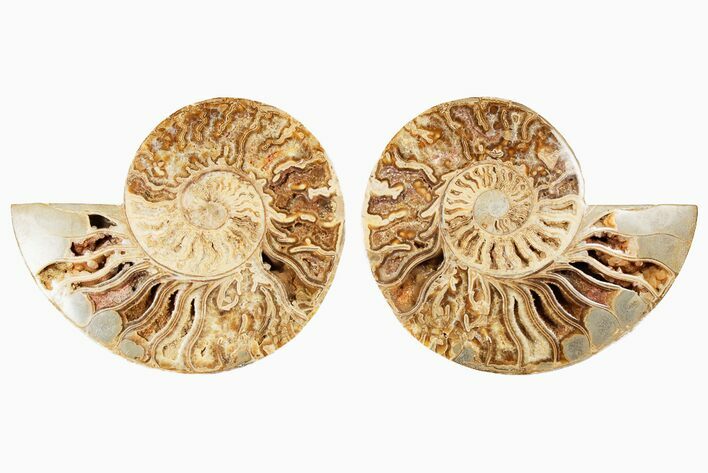This Specimen has been sold.
12" Daisy Flower Ammonite (Choffaticeras) - Madagascar
This is a nice, 12" wide example of a rarely seen ammonite (Choffaticeras sp.) from Madagascar. Ammonites of this genus are often referred to as Margarite or "Daisy" flower ammonites. It has been cut in half and polished to reveal the amazing inner detail. Some of the chambers have been preserved as deep, spectacular calcite crystal encrusted pockets. This is an extremely aesthetic and displayable ammonite fossil.
This specimen has a repaired cracks through it which is common with ammonites of this size. This listing includes both halves of the ammonite plus display stands.
This specimen has a repaired cracks through it which is common with ammonites of this size. This listing includes both halves of the ammonite plus display stands.
About Ammonites
Ammonites were ancient marine cephalopods, similar to today's squids and octopuses, but with a defining feature: their distinctive, tightly coiled spiral shells. These shells, resembling those of modern nautiluses, served as both a protective home and a buoyancy aid, allowing ammonites to navigate the prehistoric seas with ease. First emerging around 240 million years ago in the Triassic Period, ammonites thrived for over 175 million years, adapting through numerous forms and sizes. As predatory creatures, they likely fed on smaller marine organisms, using their tentacles to capture prey. However, their long reign came to an end 65 million years ago at the close of the Cretaceous, coinciding with the mass extinction event that also eliminated the dinosaurs.
Ammonites were ancient marine cephalopods, similar to today's squids and octopuses, but with a defining feature: their distinctive, tightly coiled spiral shells. These shells, resembling those of modern nautiluses, served as both a protective home and a buoyancy aid, allowing ammonites to navigate the prehistoric seas with ease. First emerging around 240 million years ago in the Triassic Period, ammonites thrived for over 175 million years, adapting through numerous forms and sizes. As predatory creatures, they likely fed on smaller marine organisms, using their tentacles to capture prey. However, their long reign came to an end 65 million years ago at the close of the Cretaceous, coinciding with the mass extinction event that also eliminated the dinosaurs.
SPECIES
Choffaticeras sp.
LOCATION
Ambatolafia, Mahajanga Province, Madagascar
SIZE
12" Wide (each half)
CATEGORY
SUB CATEGORY
ITEM
#191238
We guarantee the authenticity of all of our specimens.
 Reviews
Reviews


















